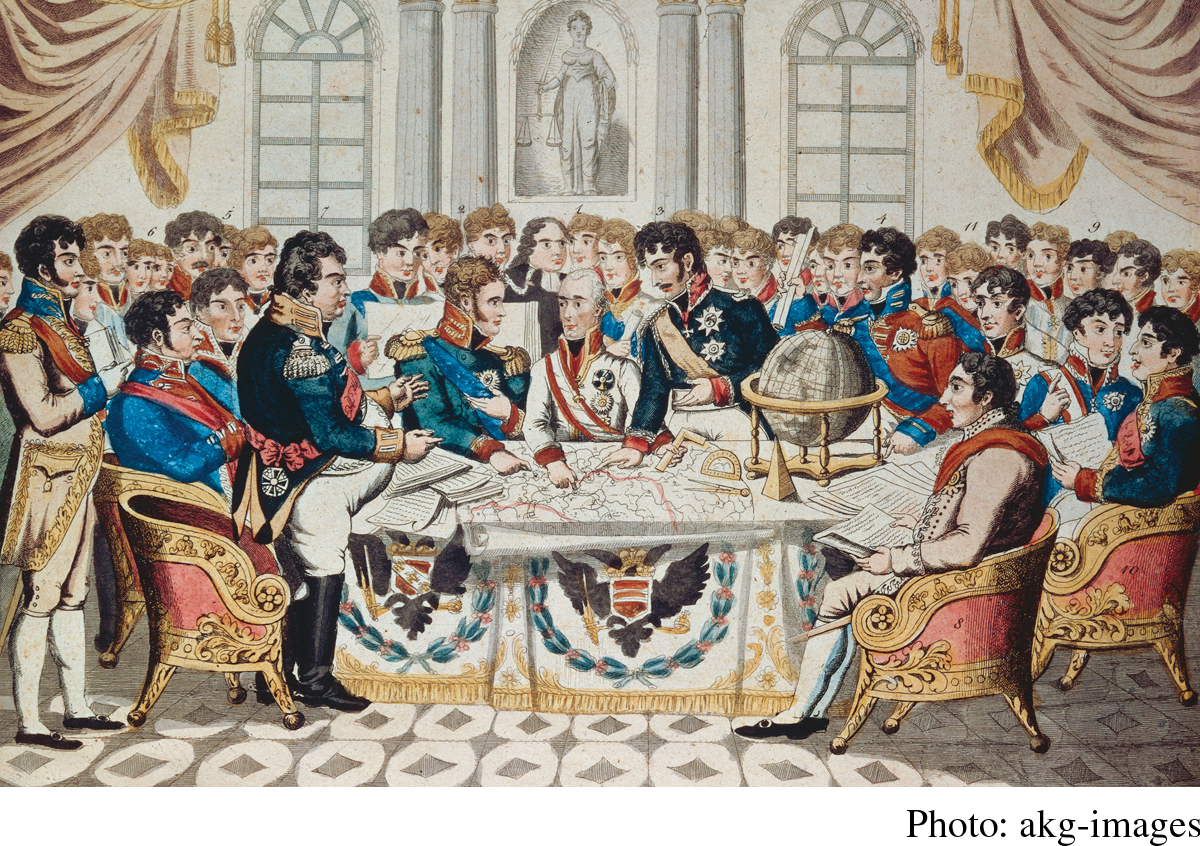The Congress of Vienna, 1814–1815
The Congress of Vienna, 1814–1815
In addition to determining the boundaries of France, the congress had to decide the fate of Napoleon’s duchy of Warsaw, the German province of Saxony, the Netherlands, the states once part of the Confederation of the Rhine, and various Italian territories. All had either changed hands or been created during the wars. These issues were resolved by face-to-face negotiations among representatives of the five major powers: Austria, Russia, Prussia, Britain, and France. With its aim to establish a long-lasting, negotiated peace endorsed by all parties, both winners and losers, the Congress of Vienna provided a model for the twentieth-century League of Nations and United Nations. The congress system, or “concert of Europe,” helped prevent another major war until the 1850s, and no conflict comparable to the Napoleonic wars would occur again until 1914.
Austria’s chief negotiator, Prince Klemens von Metternich (1773–1859), took the lead in devising the settlement and shaping the post-Napoleonic order. A well-educated nobleman who spoke five languages, Metternich served as a minister in the Austrian cabinet from 1809 to 1848. He aimed to return as much as possible to the pre-1789 political order, but to do so he also needed to maintain France’s great-power status as a counter to Russia and Prussia. He therefore worked with the British prime minister Robert Castlereagh (1769–1822) to ensure a moderate agreement. Metternich and Castlereagh believed that French aggression must be contained, because it had threatened the European peace since the days of Louis XIV, but at the same time that France must remain a major player to prevent any one European power from dominating the others. Castlereagh hoped to make Britain the arbiter of European affairs, but he knew this could be accomplished only through adroit diplomacy because the British constitutional monarchy had little in common with most of its more absolutist continental counterparts.

The task of ensuring France’s status at the Congress of Vienna fell to Prince Charles Maurice de Talleyrand (1754–1838), an aristocrat and former bishop who had embraced the French Revolution, served as Napoleon’s foreign minister, and ended as foreign minister to Louis XVIII after helping arrange the emperor’s overthrow. When the French army failed to oppose Napoleon’s return to power in the Hundred Days, the allies took away all territory conquered since 1790, levied an indemnity against France, and required it to support an army of occupation until it had paid.
The goal of the Congress of Vienna was to achieve postwar stability by establishing secure states with guaranteed borders (Map 20.2). Because the congress aimed to “restore” as many regimes as possible to their former rulers, this epoch is sometimes labeled the restoration. But simple restoration was not always feasible. The congress turned the duchy of Warsaw, for example, into a new Polish kingdom but made the tsar of Russia its king. (Poland would not regain its independence until 1918.) The former Dutch Republic and the Austrian Netherlands, both annexed to France, were now united as the new kingdom of the Netherlands under the restored stadholder. Austria took charge of the German Confederation, which replaced the defunct Holy Roman Empire and also included Prussia.

The Congress of Vienna also resolved various international trade issues. Great Britain, which had abolished its slave trade in 1807, urged the congress to condemn that trade for other nations. The congress agreed in principle; in reality, however, the slave trade continued in many places until 1850. Nearly three million Africans were sold into slavery between 1800 and 1850, and most were transported on either Portuguese or Brazilian slave ships.
To impart spiritual substance to this very calculated settlement of political affairs, Tsar Alexander proposed the Holy Alliance, which called on divine assistance in upholding religion, peace, and justice. Prussia and Austria signed the agreement, but Great Britain refused to accede to what Castlereagh called “a piece of sublime mysticism and nonsense.” Despite the reassertion of traditional religious principles, the congress had in fact given birth to a new diplomatic order: in the future, the legitimacy of states depended on the treaty system, not on “divine right.” (See “Taking Measure: Power Capability of the Leading States, 1816–1830.”)